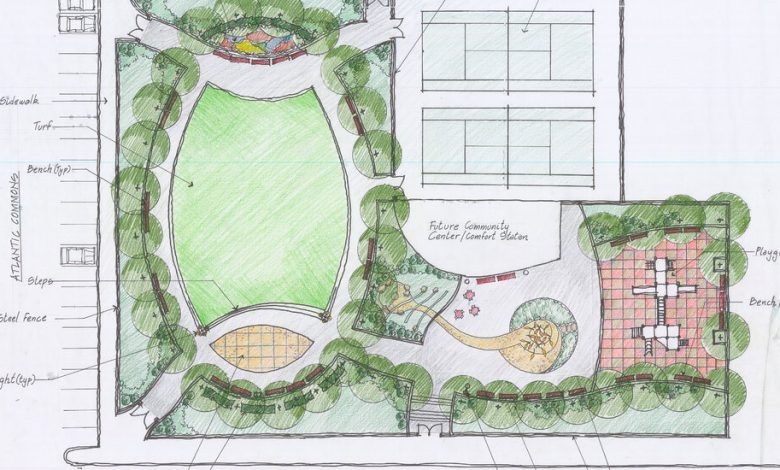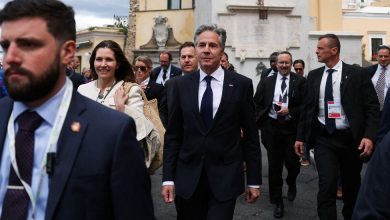For 30 Years, This Grown-Up’s Office Was the Playground

Emmanuel Thingue laughed as he nimbly scampered up the jungle gym to have his photograph taken.
At 61, he was the oldest person on the playground equipment at Lincoln Terrace Park in the Crown Heights neighborhood of Brooklyn. Around him, children whooped and romped.
But Mr. Thingue, a landscape architect who recently retired from the New York City Parks Department after 30 years, had a special connection to the space: He designed it.
Over his career, Mr. Thingue designed more than 30 New York City parks and won awards and accolades for his work. Many of the city’s most delightful spaces, beloved by local children and their caretakers, owe their particular charm — their sensibility and unique flow — to him.
Spend an afternoon with Mr. Thingue, and he will tell you how parks improved his life when he was a boy. He will persuade you that parks — especially urban parks that give city children room to play, or to just be with their thoughts in a secluded spot — can have a transformative effect, not just on individuals, but on the world.
“Let’s say, for example, your life is not going so great and being in a park allows you to think, it allows you to reflect on your life,” he said, spreading his hands wide. “Butterfly effect, who knows?”
It would be an understatement to describe Mr. Thingue as having joie de vivre: He bubbles with energy, laughs easily, smiles frequently and absolutely gushes when talking about his work.
Mr. Thingue was born in Haiti, and growing up, he thought he might become an architect.
“I used to play in mud, making mud houses,” he said. “People would say, ‘Oh, you’re really good at this.’” He laughed. “I don’t think I was very good, but you know, that reinforcement sometimes molds you into what you become.”
His family arrived in New York City when Mr. Thingue was 14, and they lived not far from Lincoln Terrace Park. He remembers visiting the rolling hills and greenery. “I was a bit of a loner,” he said. “And parks allowed me to reflect on my life.”
He graduated from Brooklyn Tech and studied architecture at City College.
It was an encounter with a professor — M. Paul Friedberg, the award-winning landscape architect and urban designer — that led him to landscape work.
Mr. Thingue wasn’t doing well in class. “I was terrible,” he said. Mr. Friedberg pulled him aside. “He said, ‘I don’t think this is for you.’” Mr. Thingue tried harder. “I stuck with it just to prove him wrong.”
Mr. Friedberg became his mentor, and hired Mr. Thingue before he graduated.
After that, Mr. Thingue started working for the Parks Department, and eventually ended up designing a magical play space in the neighborhood he first lived in as a child.
Though it is just steps away from the busy traffic of Eastern Parkway, Lincoln Terrace Park is hushed and green and feels removed from the chaos of the wide boulevard. Standing in the playground, looking north, the view is of grassy slopes dotted with trees, their leaves rustling in the breeze.
The landscape inspired Mr. Thingue’s design. “There’s undulating hills throughout the park,” he said. “If you look at the playground itself, you can see that it’s sloping, and that was on purpose.”
The playground sits on a 5 percent grade, which accommodates wheelchair users. And there are curves everywhere.
The “big kid” area of the playground operates in a continuous loop, so children can run up a ramp, go down a slide and scamper back to where they started. There are half-moon shaped steppingstones and a series of semicircular climbers, the shape of which echoes the hills behind them. There are little hiding spaces where, he says, “two kids can sit by themselves.”
There are also large trees everywhere. “I’ll sacrifice certain things about the design just so I can keep big trees,” he said. “It feels a little bit more comfortable, more natural, when you have large trees. I think people feel the presence of the trees.”
In addition to Lincoln Terrace Park, Mr. Thingue designed South Oxford Park in Fort Greene, with its huge cattail sprinklers, and had a hand in Breevoort Playground and Dumbo’s Bridge Park 2. In 2011, he won a Sloan Public Service Award — designed to recognize outstanding civil service — and was called “a Renaissance man whose ability to transform space is one reason New York has great parks and a green future.”
Asked what his dream park would be, no matter the budget or location, he was at a loss. “I was totally invested in doing parks for New York City Parks,” he said. He likes contributing to something that can inspire others, as it did for him.
Although Mr. Thingue has retired from the Parks Department, he has not stopped working. He is an adviser for New City Parks, a nonprofit organization that helps create parks for underserved communities, and doesn’t see himself slowing down anytime soon.
He will keep sketching parks until the day he dies, he said. “I feel alive when I’m doing it.”




